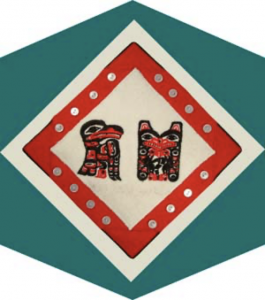Tlingit

The Block
The Raven Child and Beaver, two of the five Teslin Tlingit clans were elaborately stitched onto this block by Marian C. Horne. The three other clans are the Eagle, Frog and Wolf. The images have been created in the black and red flat-form design typical of West Coast nations, using a button-blanket style on wool stroud. Much of Tlingit visual artwork features clan crests, which symbolize their spiritual connection to the land and its creatures. Clan crests are owned by the clan, telling their history and serving as land titles.
Cultural Profile
Tlingit traditional territory lay along the farthest reaches of the North Pacific Coast, stretching from Portland Canal north to the Yakutat region. In the early years of the 18th century a group of Tlingit people migrated inland (establishing themselves collectively as “Inland Tlingits” or Teslin Tlingit) to take advantage of the salmon-rich rivers and abundant forests teeming with fur-bearing animals.
The Tlingit developed into a complex society that was both culturally and materially rich. The forests supplied shelter, game and wild berries, while the ocean and rivers were a storehouse of fish and sea mammals. With access to such a variety of natural resources they became skilled craftspeople and savvy traders. Tlingits had the most extensive trade contacts and often acted as middlemen between their coastal neighbours, the Athapascans of the interior, and the Inuit. They even traded with the Russians, consequently introducing the first Russian trade goods into the southern Yukon. The Tlingits were highly skilled navigators with seaworthy canoes; they thought nothing of paddling for days in any direction, trading as far south as Puget Sound.
In their own language Tlingit is spelled Lingit or Leengit. The Tlingit language is believed to be distantly related to Eyak (an extinct language from the Alaskan coast), as well as to the Athapaskan linguistic family. There are few left who speak Tlingit. Even so their traditions, culture, social and political patterns have remained largely intact over the years, passed on through a vibrant oral tradition. Deeply spiritual they believe animal spirits guide them throughout life, and honour these spirits by practicing totemism.
The clan system is matrilineal and remains the foundation for Tlingit social organization. It has proven instrumental in negotiating modern treaties and land claims. This system has absorbed some modern corporate, democratic principles reflective of the Tlingit world view, putting them to use in the establishment of legislative self-government. Modern Tlingit are proud and protective of their heritage and culture. Through the Teslin Tlingit Council they strive to conserve the natural environment and support a vibrant Tlingit community.
Sponsor: Feilotter Family
